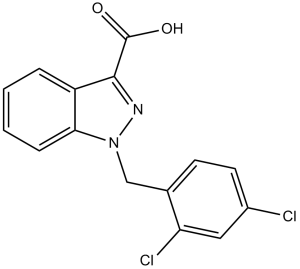This product is for research use only, not for human use. We do not sell to patients.

| Size | Price | Stock |
|---|---|---|
| 250mg | $450 | Check With Us |
| 500mg | $699 | Check With Us |
| 1g | $1050 | Check With Us |
Cat #: V2100 CAS #: 50264-69-2 Purity ≥ 98%
Description: Lonidamine (AF 1890, Diclondazolic Acid) is an orally bioactive small molecule inhibitor of hexokinase, also inhibits mitochondrial pyruvate carrier (Ki 2.5 μM in isolated rat liver mitochondria) and plasma membrane monocarboxylate transporters.
Publications Citing InvivoChem Products
Product Promise

- Physicochemical and Storage Information
- Protocol
- Related Biological Data
- Stock Solution Preparation
- Quality Control Documentation
| Molecular Weight (MW) | 321.16 |
|---|---|
| Molecular Formula | C15H10Cl2N2O2 |
| CAS No. | 50264-69-2 |
| Storage | -20℃ for 3 years in powder formr |
| -80℃ for 2 years in solvent | |
| Solubility In Vitro | DMSO: 64 mg/mL (199.3 mM)r |
| Water: <1 mg/mLr | |
| Ethanol: <1 mg/mL | |
| SMILES Code | O=C(C1=NN(CC2=CC=C(Cl)C=C2Cl)C3=C1C=CC=C3)O |
| Synonyms | AF 1890; AF1890; AF-1890; Diclondazolic Acid; DICA; Diclondazolic acid; Doridamina; Lonidamine |
| Protocol | In Vitro | Lonidamine (100 μM, 24 h) inhibits TGF-β-stimulated lactate production and oxygen consumption rate in AKR-2B and TIG-1 cells. |
|---|---|---|
| In Vivo | Lonidamine (oral administration, 10-100 mg/kg/day, d10 to d20) improves lung function by inhibiting hexokinase 2 (HK2) activity in BLM-induced pulmonary fibrosis murine model. |
| Solvent volume to be added | Mass (the weight of a compound) | |||
|---|---|---|---|---|
| Mother liquor concentration | 1mg | 5mg | 10mg | 20mg |
| 1mM | 3.1137 mL | 15.5686 mL | 31.1371 mL | 62.2743 mL |
| 5mM | 0.6227 mL | 3.1137 mL | 6.2274 mL | 12.4549 mL |
| 10mM | 0.3114 mL | 1.5569 mL | 3.1137 mL | 6.2274 mL |
| 20mM | 0.1557 mL | 0.7784 mL | 1.5569 mL | 3.1137 mL |
This equation is commonly abbreviated as: C1 V1 = C2 V2
- (1) Please be sure that the solution is clear before the addition of next solvent. Dissolution methods like vortex, ultrasound or warming and heat may be used to aid dissolving.
- (2) Be sure to add the solvent(s) in order.




































